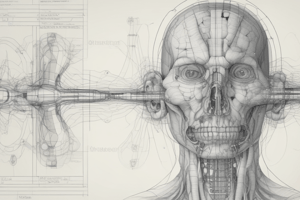Podcast
Questions and Answers
Where should the object be for the best ultrasound image?
Where should the object be for the best ultrasound image?
- At the far field
- At the interface
- At the boundary
- At the focal zone (correct)
What kind of reflection occurs when there is a small difference in acoustic impedance ($ ext{ΔZ}$) between two tissues?
What kind of reflection occurs when there is a small difference in acoustic impedance ($ ext{ΔZ}$) between two tissues?
- High reflection
- No reflection
- Low reflection (correct)
- Moderate reflection
What material is commonly used between the transducer and patients' skin to aid ultrasound imaging?
What material is commonly used between the transducer and patients' skin to aid ultrasound imaging?
- Water
- Thick liquid (jelly) (correct)
- Air
- Oil
What change occurs to a sound wave as it passes from one tissue to another with different sound velocity?
What change occurs to a sound wave as it passes from one tissue to another with different sound velocity?
What should be the orientation of the US transducer to minimize refraction?
What should be the orientation of the US transducer to minimize refraction?
Which statement is true regarding large differences in acoustic impedance ($ ext{ΔZ}$)?
Which statement is true regarding large differences in acoustic impedance ($ ext{ΔZ}$)?
What is the equation for acoustic impedance ($Z$)?
What is the equation for acoustic impedance ($Z$)?
What happens to the direction of sound waves as they pass through different tissues?
What happens to the direction of sound waves as they pass through different tissues?
Which tissue type typically uses the lowest acoustic impedance in ultrasound imaging?
Which tissue type typically uses the lowest acoustic impedance in ultrasound imaging?
Why is jelly used between the ultrasound transducer and the patient's skin?
Why is jelly used between the ultrasound transducer and the patient's skin?
Flashcards are hidden until you start studying
Study Notes
US Image Production
- Three key concepts affecting US image production: focal zone, acoustic impedance, and refraction
Focal Zone
- Objects should be at or near the focal zone of the probe for optimal imaging conditions
Acoustic Impedance
- Calculated using the formula: Z = pv
- Small ΔZ (difference in impedance) results in low reflection and high transmission of ultrasound waves
- Large ΔZ results in high reflection and low transmission of ultrasound waves
- A thick liquid (jelly) is used between the transducer and patient's skin to reduce ΔZ and allow easy passage of ultrasound waves
- When an ultrasound wave encounters a boundary between two tissues with different impedance values, a fraction of the wave energy is backscattered towards the transducer, with the remainder being transmitted through the boundary
Refraction
- Refraction occurs when the sound wave changes direction as it passes from one tissue to another with a higher or lower sound velocity
- To minimize refraction, the US transducer should be positioned perpendicularly to the interface between the two media
Studying That Suits You
Use AI to generate personalized quizzes and flashcards to suit your learning preferences.




